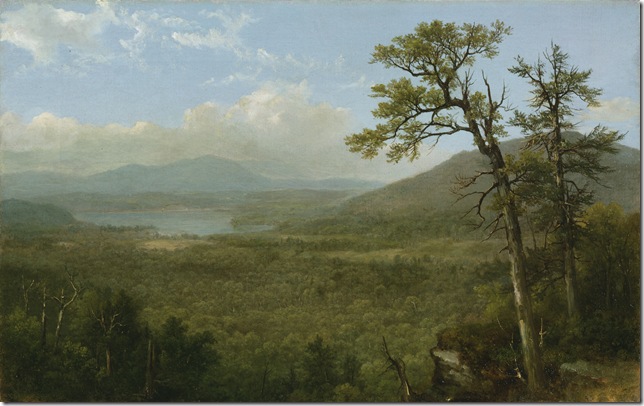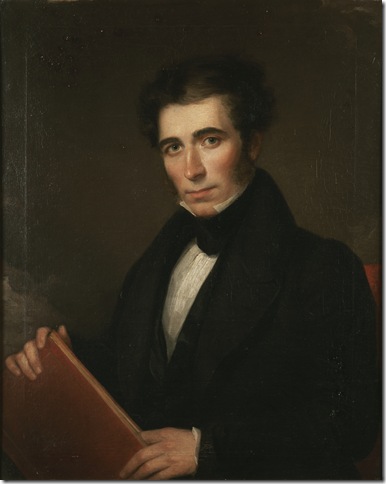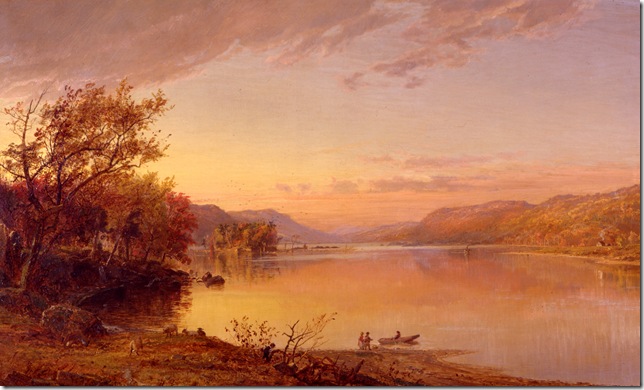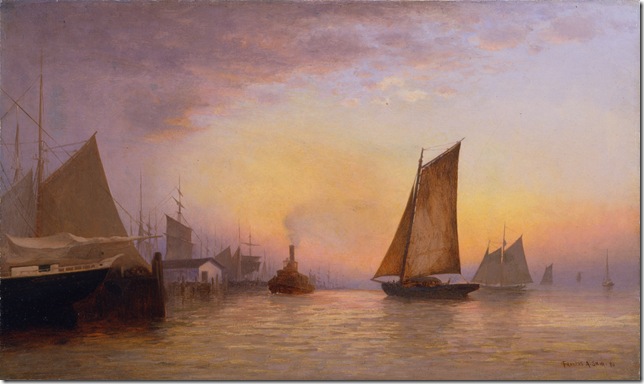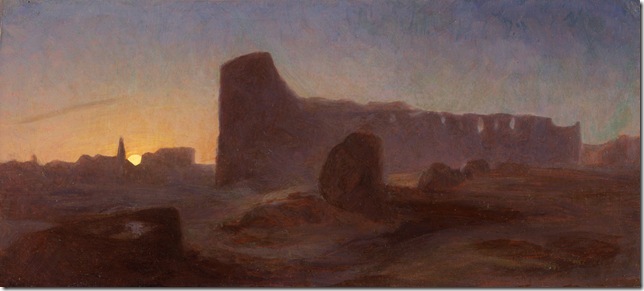In the final room of the exhibit Hudson River School Masterpieces from the New-York Historical Society, now on view at The Society of the Four Arts through Sunday, there are two striking portraits of the men considered to be the fathers of the movement: Thomas Cole and Asher Durand.
One could also pronounce them the fathers of American art because, during their lifetimes, they gave credence to the United States as a place where artists could find unparalleled inspiration – and make a viable living with their work.
Thomas Cole was merely 22 when his work was discovered, in 1825, in a New York City shop by Durand and two other painters, John Trumbull and William Dunlap. They quickly purchased all three of his paintings (for a mere $25 each) and Trumbull remarked to the dealer, “I am delighted, and at the same time mortified. This youth has done at once, and without instruction, what I cannot do after 50 years of practice.”
Durand and Cole would develop a bond of friendship that lasted until Cole’s untimely death in 1848.
When you look at the portraits of Cole and Durand, you are looking at two men who are emblematic of the idealism that dominates the work of the Hudson River School. These painters boldly traipsed the “path less taken” and returned, not just with pretty pictures, but with pictures that would later be recognized as ones that built a national identity.
The portrait of Cole was done by his friend, Daniel Huntington. In it he looks like the kind and humble man that he is often portrayed as. Durand painted his own self-portrait in which he shows himself as an earnest young man who seems to be on the verge of doing something great.
The Hudson River, which flows south 315 miles from its origin in the Adirondacks to the port of New York City, was the epicenter of American art because of both its proximity to the city, a major center for commerce and therefore a place where wealthy collectors would congregate, and because of its unbridled beauty. The painters worked from the city northward and that is how the exhibit is arranged.
“The paintings are grouped together to illustrate a trip up the Hudson River into the heart of the Catskills and beyond and then also further afield,” said curator Linda Farber, senior art historian for the New-York Historical Society.
As you travel northward on the river from the city, you move into the valley that surrounds it. It is a place of sublime beauty. There is a plethora of magnificent vistas that can still be seen today, though not quite as uncluttered. These are what inspired Cole, Durand and their followers.
Those that have seen it know that the river has moods. These depend on season and light. In the winter it can be stark and foreboding. In the autumn it can be glorious surrounded by a myriad of changing colors.
“There is dramatic weather on the Hudson and in the Catskills,” Farber said. “Artists would use this to evoke an emotional response.”
There is one mood, though, that seems to dominate and that is the serene mood that is evoked by the glow of sunlight found at either the beginning or the end of the day. This famous glow actually led to the second generation of artists – such as Frederick Edwin Church and John Frederick Kensett – to be later aptly named the Luminists.
The glow is evident, at the beginning of our journey, in New York Harbor, N.Y., by Francis Augustus Silva. It was the Hudson, after the completion of the Erie Canal, which contributed to the vibrant growth of New York City. Here, Silva captures both the busy port and returning boats with a quiet stillness.
But it was actually to escape the bustle of city that artists fled northward into the Hudson River Valley for retreat and respite. The most famous paintings of this era are of unblemished views of the valley awash in greenery with little other than nature, and an occasional traveler or animal, to dominate the canvas. Nature plays the starring role in these works, causing many to view these painters as the first environmentalists. For many, nature represented not just an escape from the banal, but also a spiritual mecca.
You can see the type of worship that was bestowed on the natural landscape in paintings such as Adirondack Mountains, N.Y., by Asher Durand. It would be easy to think that Durand may have embellished in the work, perhaps making the scenery more beautiful than it actually was. But admirers of the Hudson Valley, even today, will tell you that this is actually how beautiful the region is. So one sees through Durand’s eyes how even more awe-inspiring it was before there were houses, shopping malls and corporations dotting the landscape.
This exhibit also draws attention to the fact that many of these artists traveled to Italy as an additional source of inspiration. Cole studied and lived in Italy twice. You can see this influence in works such as his Study for Dream of Arcadia. Italy is beautifully depicted in View of the Roman Coliseum at Sunset, Italy, by Thomas Hiram Hotchkiss, amongst others. Italy represented a place of romantic ideals and historical lessons learned.
The exhibit also brings you to areas beyond the Hudson where these artists traveled for additional respite, recreation and inspiration. Jasper Francis Cropsey’s Greenwood Lake, New Jersey depicts the location of his summer home. It’s the place where he met and courted the woman who became his wife. Additional works show other areas throughout New England where these painters traveled for inspiration. It’s a joyful journey—one that has not just artistic, but deep historical, significance.
The most important part of the legacy of these artists is that they bore witness to a nascent country that would soon be engulfed by the effects of industry, which would forever change this landscape. They captured a moment and their work defined our nation to outsiders before modern communications devices were available to capture or transmit images and sounds. They felt it was their duty, and — for many — their calling, to do so.
They would convey on canvas how one feels — the quiet gasp for air — that results when being overwhelmed by the powerful beauty of nature.
Jenifer Mangione Vogt is a marketing communications professional and resident of Boca Raton. She’s been enamored with painting for most of her life. She studied art history and received her B.A. from Purchase College.
Hudson River School Masterpieces from the New-York Historical Society is now on view at The Society of the Four Arts until March 20, 2011. Hours for this exhibition are Monday through Saturday 10 a.m. to 5 p.m., and Sunday 2 p.m. to 5 p.m. Admission is $5. For more information call 655-7226, or visit www.fourarts.org.
